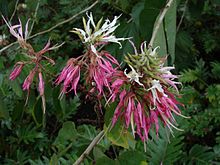User:TheJennTan/sandbox
| TheJennTan/sandbox | |
|---|---|

| |
| Bauhinia divaricata flowers | |
| Scientific classification | |
| Kingdom: | Plantae |
| Clade: | Tracheophytes |
| Clade: | Angiosperms |
| Clade: | Eudicots |
| Clade: | Rosids |
| Order: | Fabales |
| Family: | Fabaceae |
| Tribe: | Bauhinieae |
| Genus: | Bauhinia L.[1] |
| Type species | |
| Bauhinia divaricata L.
| |
| Species | |
|
199–289; see text | |
| Synonyms[1][2] | |
| |
Bauhinia (/boʊˈhɪniə/)[3]
is a large genus of flowering plants in the subfamily Cercidoideae[4] and tribe Bauhinieae,[5] in the large flowering plant family Fabaceae, with a pantropical distribution. The genus was named after the Bauhin brothers Gaspard and Johann, Swiss-French botanists.
The species "grandidieri" is endemic to south and southwest Madagascar and is named after Alfred Grandidier, a French naturalist and explorer particularly interested in Madagascar.
Description
[edit]Bauhinia trees typically reach a height of 6–12 m and their branches spread 3–6 m outwards. The lobed leaves usually are 10–15 cm across.
The five-petaled flowers are 7.5–12.5 cm diameter, generally in shades of red, pink, purple, orange, or yellow, and are often fragrant. The tree begins flowering in late winter and often continues to flower into early summer. Depending on the species, Bauhinia flowers are usually in magenta, mauve, pink or white hues with crimson highlights.
Cultivation
[edit]Propagation of Bauhinia species is from seeds or cuttings. They thrive in alkaline soils and do not tolerate salty conditions. Full sun exposure is preferred but they can be grown under partial sun. Generous watering is needed during summer; moderate moisture required in winter.
Gallery
[edit]References
[edit]- ^ a b "Genus: Bauhinia L." Germplasm Resources Information Network. United States Department of Agriculture. 2007-03-29. Archived from the original on 2012-05-03. Retrieved 2010-12-06.
- ^ Wunderlin RP. (2010). "Reorganization of the Cercideae (Fabaceae: Caesalpinioideae)" (PDF). Phytoneuron. 48: 1–5.
- ^ Sunset Western Garden Book, 1995:606–607; OED: "Bauhinia"
- ^ The Legume Phylogeny Working Group (LPWG). (2017). "A new subfamily classification of the Leguminosae based on a taxonomically comprehensive phylogeny". Taxon. 66 (1): 44–77. doi:10.12705/661.3.
- ^ Sinou C, Forest F, Lewis GP, Bruneau A (2009). "The genus Bauhinia s.l. (Leguminosae): a phylogeny based on the plastid trnL–trnF region". Botany. 87 (10): 947–960. doi:10.1139/B09-065.
https://en.wikipedia.org/wiki/Bauhinia https://en.wikipedia.org/wiki/Alfred_Grandidier https://www.zimbabweflora.co.zw/cult/species.php?species_id=228490 https://www.ncbi.nlm.nih.gov/Taxonomy/Browser/wwwtax.cgi?mode=Info&id=653056&lvl=3&lin=f&keep=1&srchmode=1&unlock https://www.zimbabweflora.co.zw/speciesdata/images/22/228490-1.jpg
External links
[edit] Media related to Bauhinia at Wikimedia Commons
Media related to Bauhinia at Wikimedia Commons Data related to TheJennTan/sandbox at Wikispecies
Data related to TheJennTan/sandbox at Wikispecies
Category:Taxa named by Carl Linnaeus Category:Pantropical flora Category:Fabaceae genera
